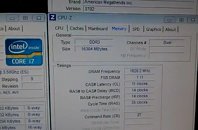- Joined
- Oct 9, 2007
- Messages
- 47,649 (7.44/day)
- Location
- Dublin, Ireland
| System Name | RBMK-1000 |
|---|---|
| Processor | AMD Ryzen 7 5700G |
| Motherboard | Gigabyte B550 AORUS Elite V2 |
| Cooling | DeepCool Gammax L240 V2 |
| Memory | 2x 16GB DDR4-3200 |
| Video Card(s) | Galax RTX 4070 Ti EX |
| Storage | Samsung 990 1TB |
| Display(s) | BenQ 1440p 60 Hz 27-inch |
| Case | Corsair Carbide 100R |
| Audio Device(s) | ASUS SupremeFX S1220A |
| Power Supply | Cooler Master MWE Gold 650W |
| Mouse | ASUS ROG Strix Impact |
| Keyboard | Gamdias Hermes E2 |
| Software | Windows 11 Pro |
An anonymous overclocker cracked a staggering DRAM speed (for dual-channel), using Intel Core i7-3770K processor (engineering sample) and ASUS Maximus V Gene motherboard, at DDR3-3256 MHz. The overclocker started off at DDR3-3153 (~1576 MHz actual) on boot, and carefully notched it up to DDR3-3256 (1628 MHz actual) in Windows. 16 GB of memory of an unknown make, was used.
What makes the feat impressive is that such DRAM clock speeds are difficult for dual-channel/multiple-module setups, and reserved only for single-module feats. Ahead of the launch of the 3rd Generation Core "Ivy Bridge" platform, every motherboard vendor is covertly showing off similar overclocking feats.

A video recording of the feat follows.
View at TechPowerUp Main Site
What makes the feat impressive is that such DRAM clock speeds are difficult for dual-channel/multiple-module setups, and reserved only for single-module feats. Ahead of the launch of the 3rd Generation Core "Ivy Bridge" platform, every motherboard vendor is covertly showing off similar overclocking feats.

A video recording of the feat follows.
View at TechPowerUp Main Site
Last edited by a moderator:




